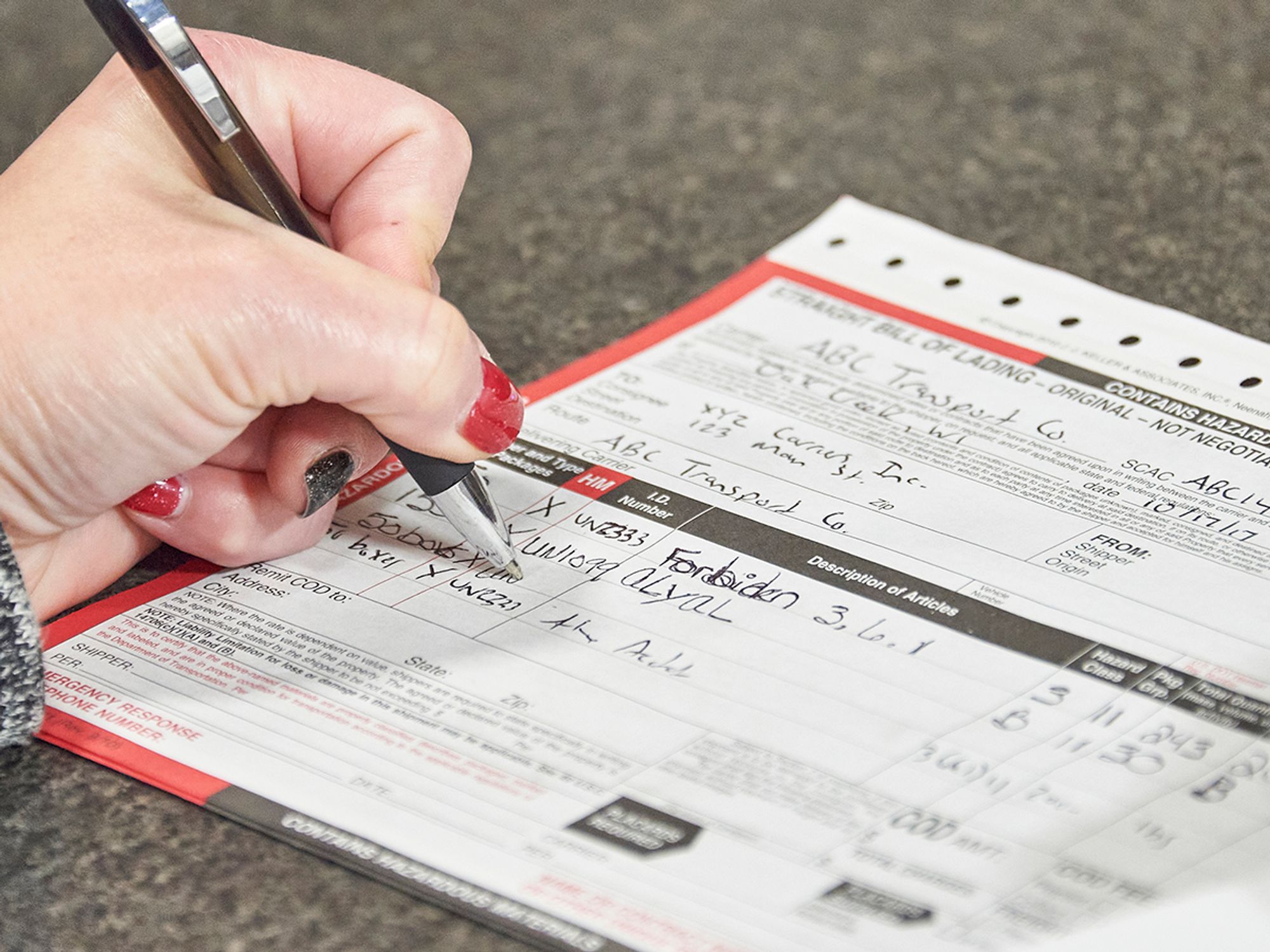Additional description categories

- Additional information about a hazardous material, such as its technical name, reportable quantity, and more, must sometimes be included on a shipping paper along with the basic description.
Sometimes, additional information is required with the basic description. See 172.203 for more information.
Technical names
With some exceptions, proper shipping names identified by the letter “G” in Column (1) of the Hazardous Materials Table (HMT) must include technical names in parentheses. Most not-otherwise-specified (n.o.s.) and other generic proper shipping names must have the technical name of the hazardous material entered in parentheses in association with the basic description. The word “contains” may be used with the technical name. The regulations allow that if a technical name is required, it may be entered between the proper shipping name and the hazard class or following the basic description.
Organic peroxides, which may qualify for more than one generic listing, depending on concentration, must include with the technical name the actual concentration being shipped or the concentration range for the appropriate generic listing.
A Division 6.2 material with the ID number UN2814 or UN2900 that is suspected to contain an unknown Category A infectious substance must have the words “suspected Category A infectious substance” entered in parentheses in place of the technical name.
If a hazardous material is a mixture or solution, the technical names of at least two components most predominantly contributing to the hazards of the mixture or solution must be entered. A mixture or solution not identified specifically by name in the HMT — that consists of a nonhazardous material and a hazardous material identified in the HMT by technical name — may be described using the proper shipping name of the hazardous material and the qualifying word “mixture” or “solution”, as appropriate. In 172.101(c)(10) some restrictions apply, such as the hazard class, packing group, or subsidiary hazard of the mixture or solution must be the same as the hazardous material identified in the table.
Example: The proper shipping name for a solution of Brucine and a non-regulated material could be “Brucine solution.”
Except for some Class 7 descriptions, if the name of a hazardous substance is not identified in the proper shipping name for a material, the name of the hazardous substance must be entered in parentheses in association with the basic description. If a material contains two or more hazardous substances, only the names of the two substances with the lowest reportable quantities (RQs) must be entered. For hazardous waste, the waste code (such as D001), if appropriate, may be used to identity the hazardous substance.
Examples:
- UN1760, Corrosive liquids, n.o.s. (Caprylyl chloride), 8, II
- UN3102, Organic peroxide type B, solid, 5.2, (dibenzoyl peroxide, 50-100%)
- UN2924, Flammable liquid, corrosive, n.o.s., 3, (8), II (contains methanol, potassium hydroxide)
- NA3082, Hazardous waste, liquid, n.o.s. (D001), 9, III, RQ
Reportable quantity (RQ)
If the material is a hazardous substance, the letters “RQ” must appear either before or after the basic description. The letters “RQ” may be entered in an HM column on a shipping paper in place of the “X.”
Limited quantity
When a shipping paper is required for a material being shipped as a limited quantity, the words “Limited Quantity” or the abbreviation “Ltd. Qty” must be entered following the basic description.
Elevated temperature material
The fact that a material is an elevated temperature material must be indicated in the proper shipping name (such as “Molten” or “Elevated temperature”) or the word “HOT” must immediately precede the proper shipping name.
Poisons
For all materials meeting the poisonous by inhalation criteria, the words “Poison-Inhalation Hazard” or “Toxic-Inhalation Hazard” and the words “Zone A,” “Zone B,” “Zone C,” or “Zone D” for gases, or “Zone A” or “Zone B” for liquids, as appropriate, must be added on the shipping paper immediately following the shipping description. For anhydrous ammonia transported within the U.S., only the words “Inhalation Hazard” must be added in association with the shipping description.
Marine pollutant
If a material is a marine pollutant, the words “Marine Pollutant” must be entered in association with the basic shipping description, unless the proper shipping name indicates that it is a marine pollutant.
Empty packaging with residue
For other than tank cars, the description on the shipping paper for a packaging containing only the residue of a hazardous material may include the words “RESIDUE: Last Contained * * *” immediately before or after the basic description of the hazardous material last contained in the packaging.
For a tank car containing residue, the description on the shipping paper must include the phrase “RESIDUE: LAST CONTAINED * * *” immediately before or after the basic shipping description or immediately preceding the proper shipping name of the material on the shipping paper.
Organic peroxides and self-reactive materials
For Division 5.2 (organic peroxide) and Division 4.1 (self-reactive) material, the following information must be included in the description on a shipping paper, as appropriate:
- When temperature control is required for transport, the control and emergency temperature;
- The word “SAMPLE” in association with the basic description for samples; or
- If notification or competent authority approval is required, a statement of approval of the classification and conditions of transport.
Non-odorized LPG
When non-odorized liquefied petroleum gas is offered for transportation, the word “non-odorized” or “not-odorized” must be included in association with the proper shipping description on a shipping paper.
